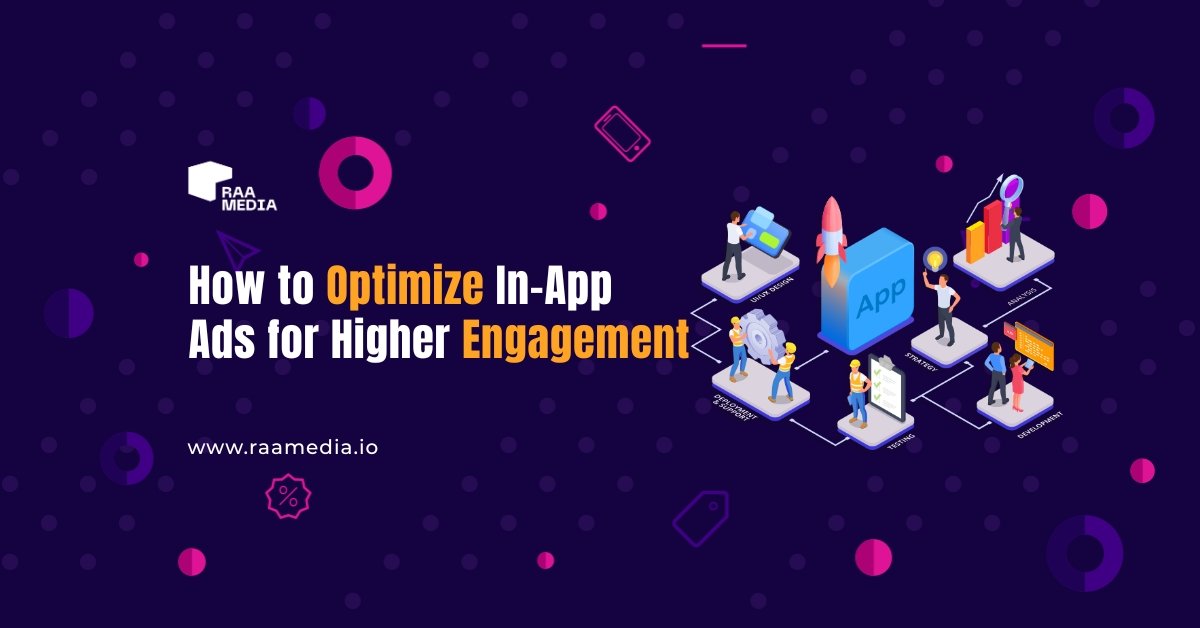In-app advertising allows app developers and publishers to cash in on growing demand for mobile ad inventory. In-app ads is a great strategy for app publishers to improve revenue by showing ads to users while they are using an app.
While this may result in better user engagement with ads, publishers need to ensure that the ads do not disrupt the user’s experience, and are relevant to the content the user is already consuming. Otherwise, app publishers could see a dip in user engagement with their apps.
In this guide, we will take a deep dive into in-app advertising, how it works, and the crucial trends you need to know about that drive in-app advertising. We discuss the benefits for publishers of mobile website display advertising versus in-app ads and finally the best in-app advertising networks to consider.
Make sure you check out how Runappads Media solves the problem of finding the right balance between monetization and user interest retention through its in-app advertisement solutions.
Table of Contents
ToggleWhat Is In-App Advertising?
In-app advertising (IAA) is a strategy that enables developers to monetize their apps by allowing advertisers to serve ads to users. These in-app ads are served through app ad networks once developers and ad buyers agree to a deal via programmatic ad buying. When a request for an ad is raised from an app, the ad network uses algorithms to identify and deliver a high quality ad to the users in real time.
In-app ads come in different types and formats to suit the viewable space and developers can choose between various ad types to monetize their app. These include in-app display ads, native ads, interstitial display ads rewarded videos, and more.
How Does In-App Advertising Work?
In-app advertising works by helping advertisers place ads within apps.The mobile app advertising ecosystem can be thought of as consisting of two parts—buyer and seller. Ad networks act as brokers, facilitating smooth transactions between app developers and publishers (the ad inventory sellers) and advertisers (the buyers).
Here’s how in-app ads work:
- The app on the user’s smartphone sends a request to the mobile ad network or ad exchange to serve an ad.
- The ad network or exchange takes a multitude of factors into account, including user data, and then uses an algorithm to identify the best and highest-paying ad from multiple advertisers.
- The ad is then served to the mobile app in real time.
Why Is In-app Advertising Important?
In-app advertising is important because it allows app developers to generate revenue, businesses to reach their target audience, and users to discover new products and services that are relevant to them.
Here are a few reasons why it is an important aspect of mobile app monetization:
- Revenue Generation: By showing ads to users, developers can earn money from ad clicks or impressions. This allows developers to continue developing their apps and improving user experience.
- User Engagement: In app advertising can be used to engage users and encourage them to take action. This can help businesses to build brand awareness and drive sales.
- Targeting: By aggregating data on user behavior and preferences, businesses can show ads that are more relevant and personalized to users. This helps ensure higher engagement and conversion rates.
- Efficiency: In-app advertising leverages strategies such as in- app header bidding that allow for more efficient allocation of a publisher’s inventory.

For app developers, in-app advertising can be a crucial source of revenue. By integrating ads into their app, developers can generate income without charging users directly. This is especially important for free apps, which rely on advertising as their primary means of monetization.
For advertisers, in-app ads provides a targeted and highly engaged audience. In-app ads can be customized to reach specific demographics, behaviors, and interests. In-app advertising can also be cost-effective, as advertisers only pay for impressions or clicks, and can set their own budget.
Finally, for users, in-app advertising can offer a range of benefits. Relevant ads can provide users with information about products, services, or events they are interested in. In some cases, ads can even offer discounts, promotions, or other incentives.
Mobile Websites vs. Mobile Apps:
Mobile apps are shown to capture their audience’s attention, and guide them on through the brand’s marketing funnel. And while mobile websites share certain similarities with specific apps, there are some critical differences, particularly regarding digital advertising.
Whereas mobile sites track via cookies, apps (which ask users to opt-in) track via Device ID offering developers valuable audience data that is not available via cookies alone. This will be critical to publishers moving forward into a post third-party cookie digital landscape.
While cookies offer basic user data such as shopping habits and browsing history, Device IDs offer developers information such as geo location data, types of mobile devices, OS, gender, age, and wireless carrier.
Furthermore, their resistance to ad blockers and the high amount of mobile time spent in apps, makes in-app advertising work successfully for mobile publishers across the board.
The mobile app market has witnessed remarkable growth, reaching a valuation of $522.67 billion in 2025, marking a year-on-year increase of nearly 12% compared to 2023. This upward trend is expected to stay, with projections indicating sustained double-digit growth in the coming years. Advertising Revenue within this growing market continues to thrive, driven by the increasing relevance of ad placement strategies.
Over the past few years, mobile app revenues have risen, growing from $155.51 billion in 2017 to a projected $673.79 billion by 2027, an impressive 3.5-fold increase in just seven years. Meanwhile, the in-app purchase market, valued at $195.74 billion in 2025, is forecasted to grow at a robust CAGR of 20.7%, reaching a staggering $1,284.55 billion by 2034. This growth is driven by expanding smartphone usage, the popularity of mobile gaming, and the proliferation of subscription-based revenue models.
Providing an exemplary mobile experience has become increasingly important for all brands and businesses looking to build brand awareness,third-party user engagement.
Let’s take a closer look at the benefits of in-app mobile advertising.
Benefits of Optimize In-App Ads for Engagement:
Now that we know what in-app advertising is, we look at some of the benefits that it brings for publishers.
1. More Monetization Opportunities
On mobile apps, advertisers and app publishers have much more freedom to monetize the app in ways they cannot monetize a mobile website.
For mobile ad publishers, in-app ads have proven to be a successful monetization strategy. These days, smartphone app developers are making money by serving ads on their mobile apps. For example, the premier online real estate business, Zillow, publishes ads for allied businesses enabling them to reach targeted users through their app.
2. Users Spend More Time on Apps
Smartphone users today spend an average of 3 hours and 10 minutes daily on mobile apps, indicating how essential apps have become in shaping mobile experiences. While the typical user has around 80 apps installed, only 9 are used daily, with 30 revisited monthly. Notably, 90% of app usage is focused on communication, entertainment, shopping, and social media, showing the dominance of these categories. This shift highlights the growing importance of apps compared to mobile web usage.
3. More Engaged Audience
Unlike traditional marketing channels, the mobile app audience is by far the most captive and engaged, making them the ideal audience for display advertising, leading to higher interest, click through rates (CTR’s), and conversions and ultimately, higher ad revenue for app publishers.
4. Higher Chance of Conversion
Research on In– app advertising statistics shows that in-app ads are much more effective than mobile web ads. The click through rate (CTR) for in-app ads is 0.56%, which is more than double the 0.23% CTR for mobile web ads. In-app ads also have a customer conversion rate that is 150% higher than mobile web ads. Additionally, they offer a user retention rate that is three times higher than mobile web ads, making them a highly effective option for reaching and retaining customers.
5. Accurate In-App Ad Targeting
When a mobile user is browsing websites, advertisers and publishers can only accumulate data about them using cookies which is quite limited. However, when using an application, ad publishers can collect more targeted information through device ID including age, internet provider, gender, operating system, device type, location, and more.
6. More Personalization
In-app-based mobile advertising enables ad publishers to create highly personalized and customized ads that have higher odds of engaging your audience and convincing them to click through. Also, through the app store, developers always get permission from the mobile user to collect their data prior to installation. Ad publishers are also in a better position to identify their audience giving them more control over the ad serving process.
That being said, you have to keep in mind that recent loss of data tracking across apps pushed forward by the latest iteration of iOS 14 is expected to cut down the cost per mile (CPM), making personalized advertising substantially more challenging. This will increase the value of first-party data and immersive ad units significantly.
7. Better Results
According To Raa Media, in-app ads perform 11.4 times better as compared to banner ads on mobile websites. This is because their unique positioning within the user’s journey through the app allows them to command greater engagement from the user. Banner Ads, on the other hand, can simply be ignored by a user, driving little engagement.
8. No Ad Block
If a user has installed an ad blocker, it is likely they won’t see banner ads. That’s not a big concern for in-app advertisers because of the freemium business model which allows them to serve ads to the mobile users who can use the app without paying any price.

Possible Drawbacks of In-App Advertising
As brands and marketers continue to increase their marketing spend on both mobile web and in-app advertising, they also need to consider the drawbacks of in-app advertising.
Without conducting a cost versus benefit analysis, it can be challenging to make your in-app ad campaign successful. Make sure there is enough time spent on programmatic planning. Some key points you need to keep in mind are as follows:
Highly Competitive Channel
Since more and more advertisers are now looking to display their ads within apps, it has become an increasingly competitive and expensive marketing platform.
Depends on Your Business Niche
If your target customer is not a savvy smartphone user or doesn’t like to use app content, then mobile app ads may not be the best marketing fit for your brand. You will not get high enough click through rates.
Private Marketplace and Programmatic Deals
Customized programmatic deals, like those offered by Publift, ensure in-app advertising campaigns are optimized to deliver the maximum viewable mobile ad impressions to highly specific audiences at the right mobile moment. By offering high-quality inventory, in all the main ad formats, programmatic deals allow publishers on a supply-side platform to partner with advertisers on a demand-side platform to maximize ad revenue for ads in all app categories.
Build an app that attracts both consumers and sponsors!
That was all for today! As discussed, Mobile apps can make your advertisement and marketing endeavors more powerful and effective. So, supercharge your online business by complementing it with a high-performing native app.
You can Reach out Raa Media and We Can Market You Well With Our Expertise. The platform enables you to create an app, customize it, and test it for Android and iOS in a real mobile environment.
The process is such that it gives you the freedom to design the perfect app that leaves your consumers in awe and offers them a smooth and user-friendly experience.
This can ultimately grow your conversions and consumer base and eventually attract more advertisement partners and brand endorsements. So, what are you waiting for? Get an app for your business now, and add the additional revenue channel to boost your profits and growth.




